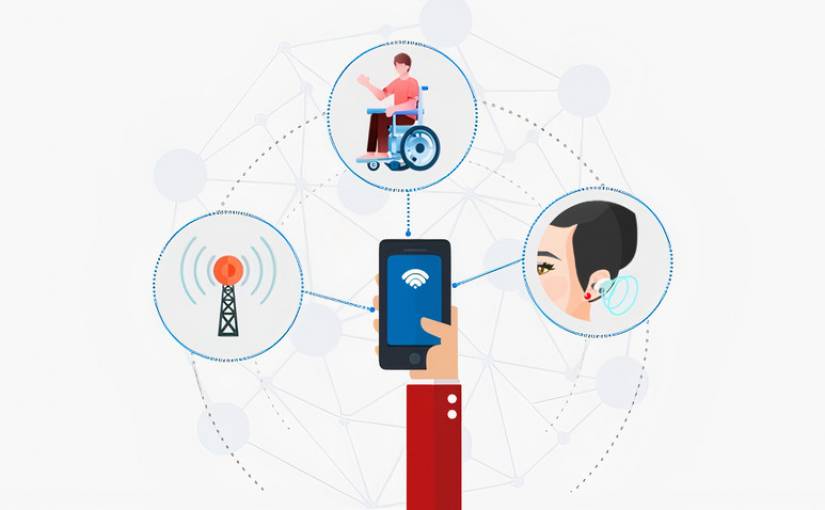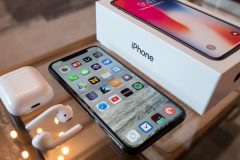The digital world has been entirely transformed with the help of technological breakthroughs, and IoT (Internet of Things) is to be credited among AI (Artificial Intelligence), ML (Machine Learning), Data Science, and more.
Internet of Things has been the futuristic concept of connecting and controlling our devices and items remotely. This future idea alone has brought drastic change within many industries that have seen improved processes, increased productivity, and many other benefits.
IoT for the Disabled – Breaking Barriers and Changing Lives
However, one of the most significant contributions that IoT has made in assisting users with disabilities. How IoT for the disabled? We’ll get to that thought in this article. For now, let’s shed light on the concept of IoT for our readers that would like to understand the technology first.
What is IoT?
The Internet of Things can be explained as a network of physical objects with sensors, software, and various other technologies embedded within them to connect and exchange data with other devices, systems, or mobile apps over the internet.
What could be those devices? They could range from regular household items, medical equipment, or industrial tools. Today, we have nearly 7 billion connected devices, with experts expecting the numbers to spike up to 10billion by 2020 and 22billion by 2025.
How Is IoT Important?
IoT is the upcoming technology of the 21st century that has allowed human connection with everyday objects like kitchen appliances, cars, house lights, and much more, enabling data sharing without any human intervention.
Basically, an ordinary item can transmit data and automate tasks without any manual control, giving new waves of opportunities to contactless during the COVID times and otherwise.
Not to mention, with low-cost computing, big data analytics, and mobile technologies, the Internet of Things is relatively cheap and easily accessible to the masses.
Of course, IoT comes with its own challenges and trends that should be kept a close eye on, not to mention the many security challenges that IoT faces. Speaking about trends of IoT, ‘AIoT’ is also a reality that includes AI playing a big role in changing three industries in particular.
IoT Statistics Declaring IoT the Technology of Today and Tomorrow
One thing is for sure: IoT is here to stay.
- IoT is set to generate $344 billion in additional revenue by 2020, reducing the costs by $177 billion.
- The global smartphone market will reach up to $53 billion by 2022.
- There will be 28.5 billion networked devices by 2022.
- Industrial IoT devices are projected to add $14 trillion to the global economy by 2030.
- 5G is expected to expand the IoT market, considering this technology is primarily concerned with bandwidth speed and time that 5G maximizes.
- Now that you are aware of IoT’s potential and what it stands for, we can move to the accessibility factor that seamlessly elevates.
How IoT for the Disabled Improves Accessibility, Especially?
We were focusing on how IoT can drastically improve the lives of disabled people addressing limited access in many ways. We also spoke about how smart homes and home automation systems are rising in popularity, allowing people to control various aspects of their home from a single place without getting up.
However, for disabled people, this technology holds much more significance. It is not adding additional value but solving some of their biggest hurdles like being unable to access specific items or devices.
How IoT is Helping the Disabled
Smart homes single-handedly allow disabled people to live more independently with an easy-access lifestyle. With the sophistication of IoT technology, it has become a possibility for disabled people to rely lesser on their caregivers.
For example, many home automation comes with customizable commands or controls, meaning one would allow you to switch on or off the lights, the other to play your music, and another to send for an emergency, so on, and so forth.
As for someone who may be suffering from vision impairment, then home automation can help tremendously. Meaning, with various home items controlled through voice assistants – it is relatively easy for anyone with a sight issue.
With neural implants, apps, and gadgets like smart glasses under development, they will allow devices to tell the user what they see. Revolutionary, right?
Let’s have a look at some practical examples.
One of the practical applications other than the famous self-driving cars is IoT to secure the Crosswalk for the disabled. How? By enabling the traffic light sensors to detect people with disabilities that might take longer to cross the road and extend the signal for longer.
Speaking about blind people, Toyota is developing a smart wearable that can be slapped onto the arm and assists the blind by detecting and reading signs through cameras. The device under construction also provides sensory assistance like sound and vibration, telling the user what is in front of them to help them navigate their way.
Although we have discussed the ways IoT helps the disabled, let’s assemble it and discuss it in detail.
IoT for the Disabled: Breaking Barriers
IoT, as discussed, has the potential to revolutionize the lives of the disabled by giving them hold on their lives to a certain extent. There are many barriers that IoT has broken for the people that find it hard to move around without a caregiver. So let’s explore them.
Improved Mobility
With the help of technological advances, many IoT devices help people with disabilities overcome their mobile issues. We have given an example of a smart Crosswalk that has sensors built-in traffic signals.
However, there is an assistive app called the Crosswalk in the Netherlands that is downloadable on smartphones. It allows the users with a specific disability to alert the traffic lights to give them extra time for crossing over.
The mobile app so far has proven to communicate with the software of traffic lights seamlessly.
Reading the Surroundings
IoT and AI combined can be a powerful combination allowing the visually impaired to see their surroundings through the camera lens’s eyes on their phone. The app made by Microsoft, called Seeing AI, can help visually challenged people understand their surroundings better.
Google has introduced cloud Vision API for developers to create applications that work as a pair of artificial eyes, enabling easy and learned mobility.
Allowing Autonomy
IoT has given the disabled some extent of autonomy. Meaning, the connected home devices like refrigerators, ovens, speaks, and other devices help the disabled be more in control of their lives and have power over how they would handle those IoT devices.
By this, IoT helps disabled individuals overcome the barriers in a social setting or on a personal level by allowing them to have more power over their devices and surroundings without having to do something they are incapable of.
Speaking of disability, IoT is playing a crucial role in healthcare as well, and this indirectly helps disabled individuals. Top life sciences consulting firms out there are doing their part of bridging the gap between technology and medicine by promoting IoT solutions within the healthcare industry.
All in all, the IoT forecast seems to be looking upwards and with a silver lining, allowing the development of cutting-edge solutions providing a better lifestyle to the disabled.
That being said, we will make sure we speak about the many vulnerabilities of this technology. Safe to say that world wars that include physical damage in this digital age aren’t that big of a threat than the cyberwar that can ruin countries and people, all from the comfort of one place.
The idea is daunting and almost sinister, considering so much of our private lives are digital. It is rightly said that technology is indeed a double-edged sword. With that being said, IoT is even more sensitive as not just your smartphones, but many of your devices are now sending data over the network that can be sniffed by third parties that do not wish well for you.
This leaves us even more curious about the security threats and challenges that IoT faces.
Largest Security Threats that IoT is Facing
Let’s start with the obvious one:
Vulnerability
One of the apparent threats in IoT devices’ weakest characteristic is being vulnerable. The vulnerability also comes from the fact that IoT devices are running on low power and less computing resource capability that do not have complex security protocols. Apart from this, it is evident that you can have the most complex of security systems in this digital age, but if not updated regularly, you too can be compromised at some point.
There is also another factor that you need to understand, and that is the two types of vulnerabilities: hardware and software. Both behave differently and are comprised differently. The hardware, of course, is tougher to penetrate as compared to the software. The software vulnerability could come because of poorly written code that leaves a loophole for cyber attackers to penetrate easily.
This is why it is of utmost importance that you code responsibly and do adequate testing to ensure there are no backdoors left.
Exposure to Harm
The second vulnerability that you find within the IoT devices is how easily it can be sniffed or exposed to third parties that do not have your best interest, as stated above. IoT devices are not the best when it comes to being resilient with an impenetrable shield. They are mostly open to access.
This does not bear well because anyone can easily steal the device, connect the device to another device that contains harmful data, and above all, change the programming of those devices in which the intruder gets complete control.
Threats
Cyber threats can come to you through several channels and disrupt your IoT device. This is why many companies heavily prioritize backing your data and enabling the option. Today IoT solutions have matured over time, and they have evolved to the point that they provide, if not the best security internally, then at least they are waterproof, fireproof, and more.
However, it is in our best interest to shed light on the cyberattacks that come with having your IoT device communicating over the network. Here are some of the attacks you should know about.
Brute force attack: This is the kind of attempt where the attackers try to guess your passwords with automated software that makes numerous attempts in guessing your password.
Controlled attacks: This includes Trojans, viruses, and DoS (Denial of Service) used to carry out controlled attacks. These are the cases where a very particular virus is created that is designed to damage and, in most cases, permanently destroy the host device. Hence, the programmers will have to be very vigilant and on guard to ensure their security is working top-notch 24/7.
Tracking the user: This kind of attack is patient yet malicious nonetheless. When your every move is being tracked by the UID of the IoT device, giving away much of the information that should have been private.
Lastly
I think it’s apparent that IoT will significantly improve the lives of people that suffer from some form of limitations and barriers discouraging them from living a normal life.
Disabled people have been marginalized for a long time. IoT, when applied correctly, has the power to break down the barriers.
Today in this digital age, nothing is unachievable in realistic boundaries. So, we can hope for more technological progression within IoT, changing the lives of the disabled for the better.










